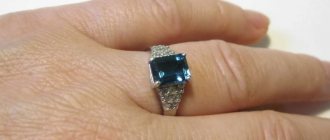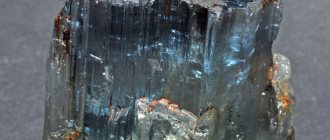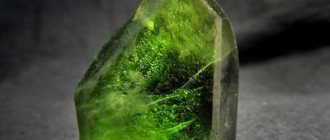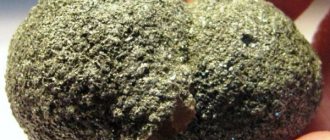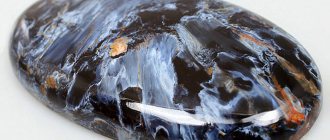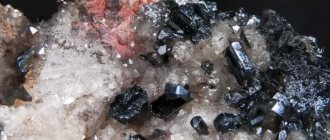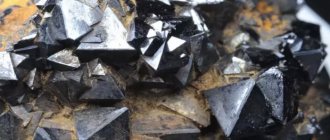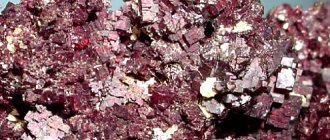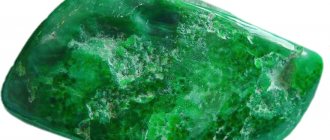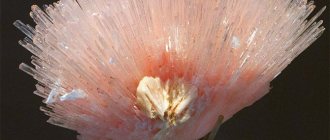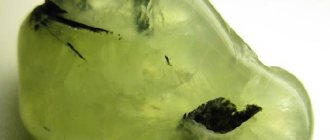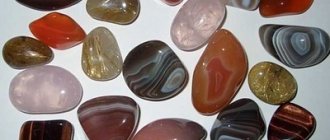Story
Thousands of years ago, pink topaz was used to make jewelry and household items, but in its raw form it attracted attention. In Europe, the mineral gained popularity during the Renaissance, when master jewelers introduced faceted crystals to society.
The history of refined pink topaz began with an accident. The wife of a Ural jeweler was baking bread and an earring with yellow topaz accidentally fell into the dough. The decoration was discovered after the finished baked goods were served. What came as a surprise to everyone was that the stone turned deep pink after being in the oven.
As an experiment, the Ural jeweler put plain-colored topazes into the oven, which eventually acquired a beautiful pink color. This discovery brought wealth and fame to the master, and the basis of the topaz refining technique is still used today.
Properties of the mineral
Pink topaz (Pink topaz) 0.31 carats
Pink topaz in chemical composition is aluminum fluorosilicate. The color scheme is formed by impurities, which include chromium, iron, and titanium. The depth of formation of the rock affects the saturation of the shade. The deeper the mineral lies, the thicker and more saturated its color.
Pink topaz has a high hardness rating of 8 on the Mohs scale and a density of up to 3.57 g/cm³. The gem is transparent with a glassy sheen, conchoidal fracture and perfect cleavage.
The pink gem is susceptible to ultraviolet radiation, due to which it loses its natural shade. To fix the color and preserve the beauty of the stone for a longer period, it can be refined - heat treated. Exposure to high temperature can correct the shade and make it more saturated.
Use in landscape design
Landscape designers recommend placing hybrid tea roses in the most prominent areas of the garden, because the richness of their color shades and classic forms create the impression of splendor, grace and nobility. It is better to use rectangular flower beds, and do not mix several varieties in one space. Flowering shrubs look great next to roses, which must be planted no closer than 1-1.5 meters, for example lilac, acacia, sea buckthorn.
The beauty of roses will also be favorably highlighted not only by deciduous, but also by evergreen coniferous shrubs, such as cotoneaster. It all depends on what effect you want to achieve - white color will give the rose garden solemnity, shades of blue and green accentuate the beauty of individual flowers.
Colors and varieties
Pink topaz, depending on the color and deposit of calves, is divided into several varieties:
- Topaz-imperial. The most expensive variety of this mineral has a wide range of shades. It comes in pink rose, lotus, raspberry, cranberry, salmon, purple and red-orange colors. Brazil is considered the birthplace of imperial topaz, but stones of this variety are also supplied by Pakistan and Sri Lanka.
Topaz-Imperial 6.22 ct
- Red topaz. The rarest type of mineral that cannot be refined. When you try to heat treat the stone becomes cloudy. Due to the impossibility of counterfeiting the color, red topaz is highly prized by jewelers and gem lovers.
Red Topaz
- Peach topaz. Absolutely transparent crystals are in demand among jewelers.
Peach topaz 19.51 carats
- Orange-pink topaz with a champagne tint. The stone is cheaper compared to other varieties, but is no less interesting and in demand among jewelers.
Natural champagne topaz 6.74 carats
Misty Rose gems created by Swarovski can also be considered a variety of pink topaz. Crystals are characterized by a milky pink color with a varied tint of powdery shades.
Photo
zelenui_goroshek
mixbuket_florist_lyudmila
exporosas
semicvetik_vlz34
flowers74ru
rose_bushes161
Place of Birth
Pink topaz is considered a rare stone; there are not so many deposits of it on the planet.
In Russia, significant deposits are located in Transbaikalia. Pink specimens are found in the central part of the Chelyabinsk region in the coastal zone of the Kamenka and Sanarka rivers. High-quality stones of pink, crimson and purple colors were mined in the Southern Urals (Kochkarsky mine), but this deposit has already been developed.
Pink topaz is mined in Brazil near the city of Ouro Preto. This area is famous for its pink topaz crystals.
Pakistan, India, and Sri Lanka are also famous for their deposits of gems. Stones of pale pink and red colors are found in Ukraine in the Volyn region.
How to propagate?
The easiest way to propagate roses is by cuttings:
- Harvesting - when the buds form, cut the shoot and make a cutting from the central part, 5-8 cm long with 2-3 leaves. The bottom edge should be under the kidney itself, and the top one centimeter above the kidney.
- Before planting, place the cuttings in a root formation stimulator for a day. For example, in water with a teaspoon of honey.
- Plant in a box or soil, deepening it 2-3 cm, be sure to add a substrate of river sand and cover with a glass jar.
- After planting, maintain high humidity by misting.
Magic properties
Pink topazes are endowed with special properties. The stone is considered a talisman for lovers. It brings harmony to relationships and reduces the likelihood of quarrels over trifles. The gem enhances the attractiveness and charm of its owner, supports the fire of passion in relationships and the interest of lovers in each other.
An amulet with pink topaz develops intuition and helps in emergency situations to find the right solution to a problem. It enhances mental abilities and logical thinking, helps you look at things rationally.
The pink beauty is also credited with the property of being a talisman against the evil eye and damage. In India, they believe that the mineral inspires hope and protects its owner from fatal actions.
Topaz for Aries
Not all representatives of this sign can afford to wear jewelry with topaz. Red topaz is more suitable for Aries than other stones. He:
- Calms violent and dangerous passions;
- Drives out feelings of anger and hatred;
- Helps accelerate tissue regeneration;
- Promotes good digestion;
- Helps in healing the liver, spleen, gall bladder.
If an Aries wears topaz, the gem prevents nervous and energy exhaustion and the occurrence of stressful situations. Women of this sign become wiser and more prudent. Jewelry with blue topaz has a beneficial effect on the function of the thyroid gland and calms the nerves.
Therapeutic effect
Topazes of natural pink color help to cope with many ailments. Their energy has a beneficial effect on a person’s psycho-emotional state. To relieve nervous overexcitation, get rid of depression, and normalize sleep, it is recommended to wear pink topaz in the form of a pendant or pendant.
The stone improves immunity, helps to more easily endure seasonal viral diseases and epidemics, and recover faster from poisoning and infectious diseases.
Pink topaz is also used to restore hormonal levels and improve the functioning of the reproductive system. The stone helps improve vision, proper functioning of the liver, kidneys and digestive organs.
The mineral can help increase metabolism, so it should be used with caution by those who are prone to obesity and bulimia.
Diseases
Does the rose have a gray-white coating or brown balls on the leaves? Methods to combat the disease.
Powdery mildew
Black spots of a round shape have appeared on the leaves of the rose, what should I do, how can I save the plant?
Black spot
The rose is sprinkled with yellow powder, the leaves and stems crack and die, how to get rid of the disease?
Rust
Has a gray coating appeared on the rose? This is gray rot that needs to be gotten rid of as soon as possible.
Gray rot
The seedling must be placed in the center of the hole, covered with soil, compacted, watered and covered with dry soil. The root collar should be deepened by 3-4 cm. In one area you can plant no more than 8 shrubs with a distance of 30-50 cm between them.
Young shrubs need to be watered frequently, every 2-3 days with 5 liters of water. It is enough to water an adult plant once a week. When roses bloom in hot weather, watering should be increased to twice a week; an adult bush needs 10 liters of warm water. It is recommended to loosen the soil at least once a week. Weeding as the area becomes overgrown.
In the first season after planting, the shrub does not need to be fed. Only in early autumn treat the bush with a sulfate solution. In the second year of the plant’s life in the spring, after pruning the shoots, the bush needs to be fed with nitrogen-containing fertilizer.
In the first fertilizing you need to apply dry fertilizers, pouring them around the trunk and moistening them. The second feeding is carried out a week later; it is necessary to use organic fertilizers, for example, mullein or bird droppings.
Rose variety Topaz does not require much fertilizer during the flowering period. It is necessary to apply mineral fertilizers once a month, alternating them with organic matter. The last feeding is carried out in early September. It is recommended to mulch the soil to reduce weed growth and improve soil quality.
Before the beginning of the growing season in spring, you need to prune the bush, cutting off dry and damaged shoots. Heavy pruning rejuvenates the bush, after which the roses become larger, but their number is reduced.
With heavy pruning, 3-4 buds are left on the bush. In summer it is necessary to cut off faded buds. In autumn, it is necessary to remove damaged stems and fallen leaves. It is recommended to burn all plant remains to prevent fungal infections.
When pruning, you need to disinfect the tool so as not to transfer the fungus from one plant to another. For the winter, the bush needs to be covered with peat and spruce branches. In regions with harsh winters, the plant must be covered with non-woven material, which is placed on top of the frame.
To prevent powdery mildew in the spring, before greenery appears, the bush must be treated with a soda solution. A common problem with the Topaz variety is green roseate aphids. For this insect, you can use wormwood tincture with laundry soap. For large colonies, chemical insecticides must be used.
Main Application
The main area of application of pink topaz is jewelry. To make jewelry, craftsmen use both natural and refined (heat-treated) gems.
Naturally colored stones are set in high-carat gold or platinum and combined in products with emeralds, diamonds and rubies.
Refined crystals are framed in silver or 14k gold and combined with cheaper minerals - rock crystal, rhodolite, peridot, cubic zirconia.
Topaz with a pink color palette is inserted into both women's and men's jewelry. In the first case, crystals of warm shades are used, in the second - more restrained, close to purple.
Compatibility with other stones
Crystals of natural origin can be worn with:
- diamonds;
- emeralds;
- rubies;
- white pearls.
In terms of energy, pink minerals do not combine with:
- rock crystal;
- jasper;
- agate;
- onyx;
- sultanite;
- black pearls.
Artificial gems are combined with:
- cubic zirconia;
- peridot;
- rhodolite;
- Swarovski stones;
- pomegranate;
- aquamarine;
- amethyst;
- zircon.
Who is suitable according to their zodiac sign?
Topazes of red-pink shades are suitable for all zodiac signs with the exception of Taurus.
The clear favorites of the mineral are Scorpios born in November. Pink topaz will have a beneficial effect on their romantic and family relationships, creativity, and character.
Leos, Sagittarius and Aries (signs of the element of Fire) can use the gem to increase physical and mental activity, get rid of character traits such as selfishness, vanity, arrogance and hot temper.
Cancers and Pisces need this mineral to gain self-confidence, reduce the threshold of suspiciousness and vulnerability, and develop communication skills.
For Gemini, the stone will help concentrate attention on important things, become restrained and disciplined.
Virgos, Libras, Capricorns and Aquarius can use pink topaz to improve their emotional state. The stone will not show other properties in relation to these zodiac signs.
Storage and care rules
Pink topaz is very difficult to store and care for. This mineral should be protected from:
- any mechanical impact;
- direct sunlight (this point applies even to refined gems);
- sudden temperature changes;
- contact with chemicals - cosmetics, perfumes, cleaning agents.
It is recommended to store the stone in a separate box with soft upholstery and wear it periodically and mainly in the evening.
It is better to entrust cleaning of products to professionals. At home, you can only remove minor stains using a soap solution and running cool water.
Useful tips
- Before planting the seedling, it is necessary to treat the root system. You need to soak the roots in water or a growth stimulator for 5-6 hours. A solution of clay, manure and water in a ratio of 2:1:1 is effective. Weak and diseased root shoots must be pruned. Preserving only strong roots stimulates the growth of the bush and improves rooting;
- In addition to watering, the shrub must be irrigated periodically, pouring warm water from a spray bottle onto the shoots and leaves. This procedure, like watering, must be carried out after sunset so that the plant has time to dry before sunrise;
- For active growth, you can use foliar feeding of 10 liters of water, 10 g of urea and 20 g of nitrate. During the budding period, you need to add 15 g of potassium to this composition and increase the amount of urea 5 times.
Difference from fake
In jewelry stores you can often find jewelry with refined topaz. Such stones are not considered fake or imitation, since they are of natural origin. You should be wary of fakes made of painted glass.
It is easy to distinguish a synthetic fake from the original:
- Real topaz is much stronger than glass. It cannot be scratched by a metal object.
- The natural mineral becomes electrified when rubbed against wool.
- Real topaz has defects in its structure - microcracks, natural inclusions.
- The original has natural shades, while painted glass has unnaturally bright colors.
- When real topaz is heated, a slight tingling sensation is felt in the palms.
Since pink topaz is an expensive stone, products containing it must be accompanied by a quality certificate, which indicates the characteristics of the mineral and the place of its extraction.
